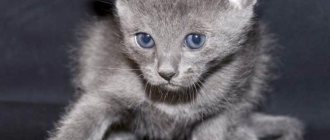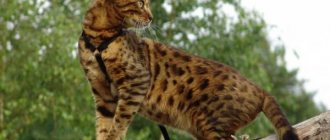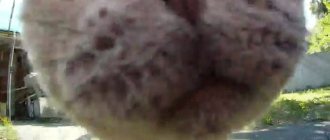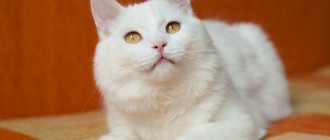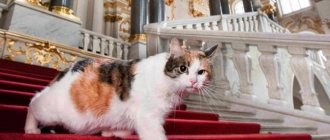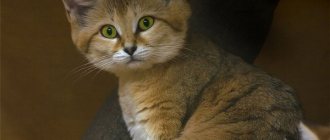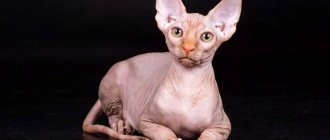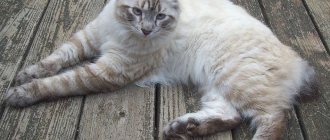A cat with a fabulous name Elf breed is not fiction. For a long time, an animal with an unusual appearance has brightened the lives of many lovers of four-legged animals. And those who have never picked up hairless cats are delighted when they look at the numerous photographs. A sweet, touching and gentle creature - this is how the rare elf cat is characterized. Her appearance reminds many of book characters from fictional novels.
A marble body, an expressive look and a sociable character are just a few of the positive characteristics of expensive pets. They are loved for their developed intelligence, playfulness and get along with other pets. They are still very rare in the world, but in the short period of existence of the breed, they have managed to win the admiration of cat admirers.
Brief history of the breed
Elves differ from other sphinxes by their curved ears.
The creator of this breed was Kristen Leed, who bred Sphynxes. After the death of her beloved pet, she decided to create a breed that would be similar to the Sphynx, but different from them in health. Her assistant was her close friend Karen Nelson.
Their choice fell on Sphynxes and American Curls. Thanks to the genes of the first breed, they expected to get hairless cats, and from curls they expected to get resistance to genetic diseases and strong immunity. The selection work took 16 years. Only in 2006, women received animals that were similar to sphinxes, but had one feature - their ears curved back. Because of this, they began to be called elves.
Defects in appearance
Since the Elf cat breed is young and “experimental”, the final standard has not been approved. Therefore, it is difficult to talk about defects in appearance. Most often, these may be too straight or curled ears (like horns), short legs.
A subspecies of elves is the Dwelf breed. Outwardly, cats look the same, only they have short legs, which is why they got their name: dwelf translates as “dwarf elf.”
You can focus on the standard of the breed of the founder - the Sphynx, but the main distinguishing feature of the elf is moderately curved ears.
Breed description, standards, appearance
Representatives of this breed are medium in size, they have a muscular body and slender limbs, large curled ears and velvety folded skin.
Elves can be very charming
Dimensions and weight
These cats have pronounced sexual dimorphism: males and females differ in size and weight. Average sizes of animals: height 20-25 cm, body length - 33-38 cm. Females weigh, as a rule, 2.5-3.6 kg, males - 3.5-5 kg.
Anatomical features
Their lean body with a wide, rounded chest is pear-shaped due to their convex belly. The tail is thin, with a pointed tip. The graceful paws are quite strong. The thin and long neck has a slight bend. The head of the sphinx has the shape of a wedge, pointed downwards, the cheekbones are quite pronounced. They have a straight nose with a slight indentation on the bridge of the nose. Large ears with a wide base and pointed tips curve back. The slightly protruding eyes are almond-shaped. Their color can be different - yellow, blue or green. Vibrissae and eyebrows are short or absent at all.
Colors and coat
There are even black elves
Elves can be any color - from white to very dark, close to black. Some cats may be spotted. Skin without hair feels like suede to the touch. The folds are most pronounced around the muzzle, on the head between the ears, near the shoulders. The bridge of the nose, the outside of the ears, paws and tail may be covered with short (up to 2 millimeters) hairs. Wool is found only in elves of the first generation, whose parents were a sphinx and a curl.
Character
Elves are considered companion cats. They are distinguished by friendliness, sociability, they are affectionate, they like to be close to their owner, they often sit on their hands. As a rule, they treat everyone who lives in the same house with them equally. Elves love to “talk.” They like to be the center of attention and do not like to be alone. They are loyal to children. At night they try to sleep next to people. They are intelligent, observant and curious animals that are interested in what people do. Kittens are very playful and mischievous, but as they grow older they become more serious. They enjoy climbing to high places. These cats can interact well with other cats or non-aggressive dogs.
If elves and a Sphynx are crossed, the offspring's ears may not roll back
Owner reviews
Those who have never seen hairless cats treat their new “elven” pet with suspicion or fear. The realization that appearances can be deceiving comes with time.
some owners are gradually changing their attitude towards elves
To be honest, I didn’t understand then how he could like such a monster. I thought the hairless cat was some kind of misunderstanding. Wrinkly baby, I would never buy one for myself. But one day, or rather two years ago, on the eve of my husband’s birthday, I saw an advertisement in the newspaper about the sale of hairless kittens. Why not, I thought, even if...
Health
To date, no genetic diseases have been identified in elves. The lifespan of these cats can be 14–18 years. But they, like other hairless cats, are prone to rashes, skin irritations and dermatitis. Such skin problems can appear due to poor nutrition or food allergies, poor hygiene, and sunburn. In young animals, hormonal surges can cause acne. Like all hairless cats, elves can catch colds; they do not tolerate cold well; drafts and temperature changes are dangerous for their health.
Content Rules
Elves need warmth. The optimal temperature for them is 23-26 degrees. To make your pet feel comfortable, you need to buy him the best thing if the animal has a bed with high sides or a house. The sleeping place should be away from drafts.
To care for your sphinx elf, you need to stock up on everything you need:
- tray;
- utensils for food and water;
- toys;
- carrying;
- harness with leash;
- scratching post;
- clothes;
- shampoo;
- wet wipes;
- ear cleaner.
Elves have an incredible sense of self-esteem
These cats need to be regularly removed from their skin. To do this, the animal is washed with warm water and hypoallergenic shampoo about once a week. Every day the animal should be wiped with wet wipes (they should not contain alcohol). Your pet's ears should be inspected about once a week; if dirty, wipe them with a cotton pad soaked in ear cleaner. To prevent plaque or tartar from forming on your cat's teeth, it is recommended that you brush your teeth weekly with a special brush and toothpaste for cats.
It is not necessary to take elves for a walk. But if the owner decides that his pet would benefit from being in the fresh air, a harness and leash are a must. The elf can be taken out into the fresh air only if it is warm outside and there is no wind. In addition, your pet will need clothing to protect from the sun and prevent burns. It should be made only from natural fabrics, no synthetics that can cause irritation. During the hot season, you can only take them out in the evening or walk in shady places. An elf's wardrobe should have several T-shirts, sweaters and overalls. Elves need clothes not for beauty, but to maintain health.
How to get a kitten
Buying a kitten is problematic; there are only a few reliable nurseries. Kittens that have reached 3 months of age, are vaccinated, and are independent are offered for sale. The seller is obliged to provide the buyer with a pedigree and a veterinary passport with vaccination records.
Do not buy a kitten without documents. The risk of stumbling upon a scammer selling an ordinary sphinx or a mongrel shaved animal is great.
A purebred Dwelf kitten externally meets breed standards. Healthy kittens are playful, inquisitive, non-aggressive, and not shy. Tears, nasal passages, ears, anus are clean. There are no scratches, wounds, or signs of dermatological diseases on the skin.
Price and nurseries
There are no breeders selling Dwelf cats in Russia and the CIS. You should look for purebred kittens in American nurseries.
The cost of kittens is high. The minimum price for a kitten in the pet category (companion) is 120 thousand rubles . You will have to pay several thousand dollars .
Nutrition
There are even spotted elves
Elves are prone to allergies, and they may also have problems with the digestive system. The best option for such cats is super premium food. Special food for animals with digestive problems is also suitable. It is not recommended to feed dry and wet food at the same time.
Natural food is also suitable for these animals: rabbit, chicken or turkey fillet, veal, beef, offal and sea fish every 7-10 days. The diet should include cereals, vegetables, and dairy products. Buckwheat, rice and oatmeal are best; you can add a little carrots, broccoli, and spinach to the meat.
Elves are strictly prohibited from giving the following foods:
- bread, cookies, buns;
- sweets, cakes, chocolate;
- salted, fried, spicy or smoked foods;
- salo;
- potato;
- mushrooms;
- beans;
- whole milk.
Feeding the cat
Elven sphinxes are big eaters. Due to their accelerated metabolism, their diet should be enriched with calories, proteins, carbohydrates and fiber.
When feeding dry food, Elf cats are given high-quality premium or super-premium products, without any questionable additives. The following brands are best suited for representatives of the breed:
- Royal Canin;
- Acana;
- Monge;
- Gemon.
With natural feeding, the diet of the Elven Sphynx should consist of 70-80% lean fresh meat. Also, a cat of this breed is given:
- eggs;
- boiled vegetables;
- porridge with water;
- offal;
- lean sea fish;
- dairy products.
Elves are forbidden to give bones, fatty meat, sausage, smoked meats, pickles, sweets and baked goods. You also need to make sure that fresh milk and any leftovers from the owner’s table do not get into the cat’s bowl.
Breeding and sterilization
Little elves need care
Due to the youth of this sphinx breed, there are not many elves yet. Accordingly, it is quite difficult not only to acquire breeders, but also to find a partner if the breeder has only one animal. The main distinguishing feature - curved ears - is not found in all kittens. Here a lot depends on the pedigree of the parents. Also, breeders should take into account that a Canadian Sphynx and an elf can interbreed, but in this case there is a high probability of genetic diseases appearing in the offspring.
The optimal birth frequency is once a year; if the cat is in good health and the pregnancies are easy, 3 litters are allowed in 2 years. Animals must have their medical records and pedigrees in order, have all their vaccinations and be dewormed. The breeder must vaccinate the kittens, carry out parasite prevention and complete all necessary documents.
If the owner, when purchasing an elf kitten, does not plan to engage in breeding, it is most advisable to carry out castration or sterilization. It is best to carry out this procedure between six and nine months. Surgeries at an earlier age can be hazardous to your pet's health. If castration is carried out later, in adulthood, by that time the cat may have formed the habit of leaving marks on its territory and trying to escape in order to communicate with females.
Even small kittens can look very menacing
Interesting Facts
In the short time the breed has existed, many interesting things have been associated with it:
- Elves are very rare and expensive cats. Since nurseries specializing in breeding the breed are concentrated in the United States, the average price of such a kitten is $1,500-2,000.
- These cats received the name “elf” due to their unusual appearance and bizarrely curved ears. And because of their resemblance to hairless Canadians, they are often called elven sphinxes.
- Due to the difficulties associated with finding a partner for mating, in some countries it is not prohibited to crossbreed Canadian Sphynxes and elves. True, kittens born from such a mating will be considered mestizos and some of them will turn out to be straight-eared.
Does elf cause allergies?
One of the main questions that concerns all hairless cat breeds is whether these animals are hypoallergenic if they do not have hair? In reality, the cause of allergies is not the fur itself, but a special type of protein that is found in saliva and skin secretions. When a cat washes itself, this protein remains on the fur. When drying, microparticles rise into the air and enter the respiratory system, causing an allergic reaction. Therefore, even hairless cats cannot be considered hypoallergenic.
